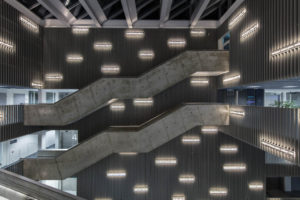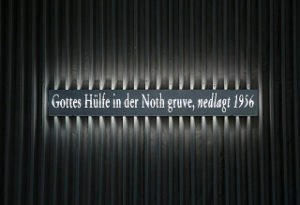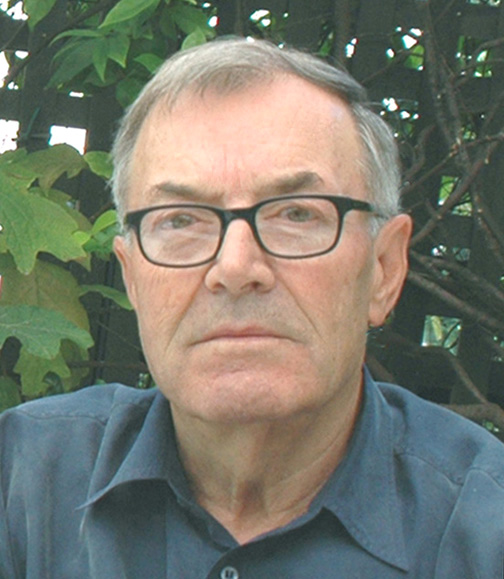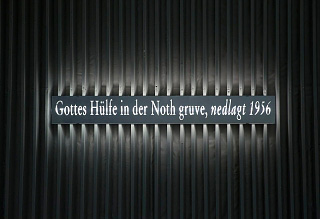In “Juliet” art magazine (print edition) I’m publishing a survey in installments on Urban Art, that is the creation of art works in public spaces – spontaneous or planned, without permission or authorized – separate from the by now institutionalized Public Art and, for other aspects, also from the historical graffiti. I’m involving Italian and foreign personalities representing varied fields. The initiative springs from the necessity to arouse an articulate reflection on a growing number of artistic works in residential areas, to create a larger debate about the phenomenon.
Here is the contribute of the conceptual artist Joseph Kosuth, one of the most important at an international level, who in the work reproduced here, has established an intense dialogue with the local history and the architectural structure in which he made the installation.
Luciano Marucci: Beyond the conceptual linguistic message, typical of your work, with your installations in urban spaces do you always try to establish a cultural relationship with the place?
Joseph Kosuth: I said quite early in my activity that artists don’t work with forms and colors, we work with meaning, and this is the case even when forms and colors participate in the production of that meaning, as they usually do. This understanding is central to my practice. Works which are based solely on the manipulation of forms and colors are on a path that leads to a cultural meaning as decoration and design as an end it itself. These certainly have their place and a value in our world, but art has another role, one which gives it political roots: it must have a reflexive relation with culture itself, thus it must ask questions of itself, how it is generated – indeed, how meaning itself is produced in culture and to show that. This gives it a political value as well as a philosophical one.
What do you think about the spread of Urban Art?
It is a radically more democratic form of what we’ve always had. And it certainly is an improvement on Generals on horses. The power of its recent form has been its existing without institutional engagement and permission. But even that is now changing.
In wider terms, from a aesthetic and social point of view, how do you consider the quality of one person works or collective projects?
They both make important contributions. I have tried to work in collaborative groups with, shall we say, uneven success. Certainly a different kind of art is the result.
Should the responsible authorities in charge discipline the street artist’s creations of works?
Responsible to whom? The absence of rules and laws risks chaos, that’s certain, but chaos isn’t always negative – that we’ve learned by now. The real problem is that both works inside and outside are more often than not very derivative and repetitive. Originality (another word for authenticity) is scarce both inside and outside of the building.
Could the artist’s actions ruin the features of the cities or could they enhance them?
Clearly both, as they are.
Do you think that the matter should be debated by artists, critics, curators … together with those authorized for public affairs to obtain a regulation in this field?
The sounds pretty awful. Probably we just need to improve the conversation about it.
February 20th, 2018
curated by Luciano Marucci

Joseph Kosuth “A Monument of Mines”, 2015, installation in Krona Cultural and Educational Centre of Kongsberg, Norway (courtesy of Galleri Brandstrup, Oslo and Joseph Kosuth Studio)

“A Monument of Mines”, 2015, detail, Krona Centre for Knowledge and Culture, Kongsberg, Norway (ph Sigurd Fandango 2015)
In the Krona Cultural and Educational Center, on the inside walls of the structure, Joseph Kosuth created an installation of 136 neon works indicating the names of the silver mines opened in that area over time along with the year for each of their closure. The Artist explains: “It’s like a graveyard of the silver mines. When you observe the work, you get to understand the whole history of this area”.

I’m Luciano Marucci, born by case in Arezzo and I look my age… After a period in which I dedicated myself to journalism, applied ecology, environmental education and traveling the world, I occasionally collaborated as an art critic with specialized magazines (“Flash Art”, “Arte & Critica”, “Segno”, “Hortus”, “Ali”) and with varied cultural periodicals. Since 1991 in “Juliet” art magazine (in print and edition) I have regularly been publishing extensive services on interdisciplinary topics (involving important personalities), reportages of international events, reviews of exhibitions. I have edited monographic studies on contemporary artists and book-interviews. As an independent curator I have curated individual and collective exhibitions in institutional and telematic spaces. I live in Ascoli Piceno.







NO COMMENT